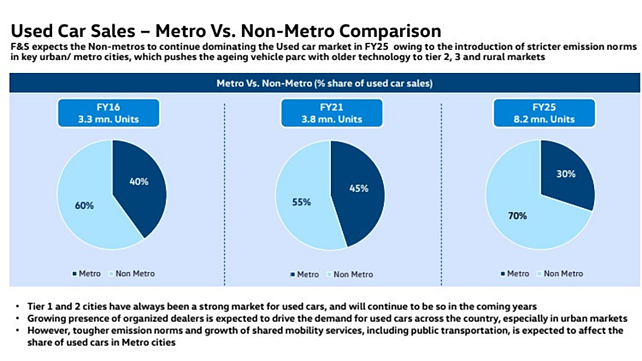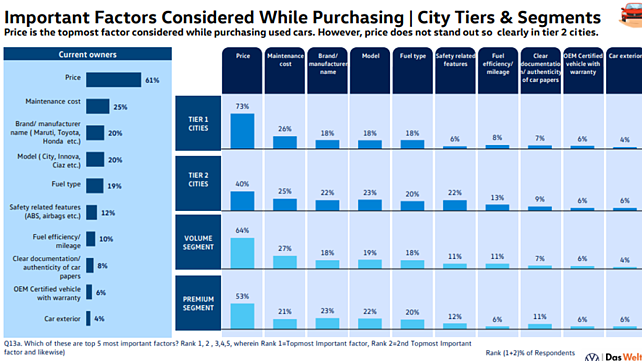
Digvijay Singh, 35, a native of Moradabad started exporting brass utensils and equipment three years back. And as his business flourished, he started upgrading his lifestyle with new gadgets, revamped home interiors and even bought a Royal Enfield Classic from his friend, who moved to Delhi to join a multinational.
But after three years of hard work and decent profits, Singh is now keen on buying a car – not just for his family, but also undertake more business trips to Delhi NCR.
Singh doesn’t want to settle for less as he wants to impress his clients too. Entry-level cars were not his consideration; his eyes were set on a premium hatchback or a compact sedan. New cars were somehow out of his budgetary reach, and he finally settled for a four-year-old Hyundai Elite i20 for INR 5.4 lakh.
Digvijay Singh isn’t alone. There are many like him, who are ditching new for pre-owned vehicles. There are many benefits – at the price of a segment below new car, one can opt to go a level up with better safety, performance and also giving them a sense of achievement. Apart from the need to own better cars, there are other factors influencing the purchase decisions of the consumers.
Volkswagen-Frost & Sullivan study on pre-owned cars
Leading German car manufacturer, Volkswagen and Frost and Suvillian recently released the “Indian Pre-Owned Car Market Study” that has identified more such trends in the pre-owned car market.
The study revealed that the pre-owned car market is expected to grow at a CAGR of 21% and reach 8.2 million units by FY25. This would increase the pre-owned to new car ratio from 1.5 in FY21 to 2.1 in FY25.
Ashish Gupta, Brand Director, Volkswagen Passenger Cars India said, “The study highlights that the market share in the organised sector will touch 45% by FY25 from the current 25%. This is a clear indication of the change in consumers’ preference in personal mobility. Pre-owned car sales will see further growth as compared to new car sales.”
“With the aim to tap this growing opportunity, we are relentlessly working towards strengthening our offerings for customers through our national pre-owned car network, Das WeltAuto (DWA). In addition, we believe that Tier 2 markets will play a critical role in our pre-owned car business volumes and the customer insights from the study will further aid us in addressing their requirements through our customised solutions,” he added.
There is increasing demand for pre-owned cars in Tier 2 & Tier 3 cities, largely on the back of growth of organised players offering reliable products and services.
Interestingly, the pre-owned car market has observed a CAGR of just 2.8% in the last five years between FY16 to FY21. Experts indicate the slow growth in the pre-owned car market in the last five years was because of lack of transparency, fewer options in a particular market and a fragmented unorganised market.
But at the same time, the next five years look promising as more and more organised players are beefing up operations and increasing digitalisation in the segment has opened new and wider options for the customers to buy and sell pre-owned cars.
The VW-F&S study also finds out that the share of organised players in the pre-owned car market is expected to grow from 25% in FY21 to 45% by FY25, driven by new business models, changing customer preferences and belief systems. As online platforms drive accessibility, convenience and transparency, around 15-20% of sales for unorganised dealers are currently completed with the help of online platforms.
Read Also - Tier-II, Tier III Cities Play A Key Role in Expanding Used Car Segment: VW-F&S Study
F&S expects the non-metros to continue dominating the pre-owned car market till FY25 owing to the introduction of stricter emission norms in key metro cities, which pushes the ageing vehicle parc with older technology to Tier 2, Tier 3 and rural markets.
Tier 2 and Tier 3 cities have always been a strong market for pre-owned cars and will continue to be so in the coming years. Further, the growing presence of organised dealers is expected to drive the demand for pre-owned cars across the country, especially in urban markets.

However, tougher emission norms and growth of shared mobility services, including public transportation, is expected to affect the share of pre-owned cars in metro cities.
Kaushik Madhvan, Vice President, Mobility (Automotive & Transportation) Practice, Frost & Sullivan said the general spending trend in Tier 2 and Tier 3 cities has increased because of multiple factors. An increase in average salary, the proliferation of multi-brand FMCG, and the rise in online transactions with smartphones have all contributed to an upward trend in spending, which is also reflected in cars.
The pandemic has also given rise to personal mobility and the desire to own a vehicle is much stronger in Tier 2 and Tier 3 cities than in metros, he said.
Key factors influencing pre-owned car buyer
Just like a new car, buyers of pre-owned cars are concerned about various factors, including price, maintenance cost, brand, model, fuel type, safety-related features and fuel efficiency. Price is the topmost factor considered, while purchasing pre-owned cars. However, price does not stand out so clearly in Tier 2 cities.
Price is followed by the desire to own a vehicle as the primary driving force. About 72% of pre-owned car buyers have a strong desire for car ownership. About 94% of the current owners are the final purchase decision-makers, while 57% are influenced by their spouse and 52% by other family members.

Online and Google search is the primary source of information but about 69% ask their family and friends followed by local pre-owned car dealers.
In terms of preference and choice, about 56% purchased mid variant cars, followed by 33% purchasing top variants. Also, contrary to the new car market, pre-owned car buyers are more inclined toward diesel fuel type than petrol type, the study revealed.
Interestingly, about 64% of the respondents are first time buyers. A major shift is happening from buying a new entry-level car to buying a higher segment pre-owned car – as has been demonstrated in the case of Digvijay Singh.
The study also found that cash transactions are the most favoured payment mode in the pre-owned car segment. Preference for online transaction is marginally more in Tier 2, than in Tier 3 cities and finance options are more desired in Tier 1 cities and in the premium segment.
Growing opportunity in pre-owned car finance
The VW-F&S study found that finance penetration in pre-owned cars is estimated to be close to 21% in FY21, compared to 77% finance penetration in new cars.
The study estimates that by 2025 pre-owned car finance will increase from 21% to 35% because the increasing share of finance penetration in non-metros is indicative of the strong demand for pre-owned cars in Tier 2, Tier 3 and rural markets.
The primary driving force behind the rise of pre-owned car finance are primarily organised players offering better financing options to differentiate themselves from unorganised players. Apart from this, bundling of vehicle finance with warranty & insurance, increasing awareness of pre-owned-car financing in Tier 2 and Tier 3 cities, lower interest rates and increasing cost of pre-owned car purchase will further expand the market.
Outlook
The pre-owned car market is poised for healthy growth as the pandemic has made consumers realise the need for personal mobility for themselves and family. Moreover, the rising aspiration of car buyers is primarily leading consumers to shift for higher segments in the pre-owned car market ditching the new cars.
The study revealed that the availability of newer generation vehicles has made the purchase of pre-owned cars more attractive than ever before, which are loaded with better safety, infotainment and powertrain features. Moreover, OEM business models are enabling transparency and trust, eliminating the stigma associated with the purchase of pre-owned cars. With OEMs offering warranty and service support, the pre-owned car market is instilling trust in first-time buyers.